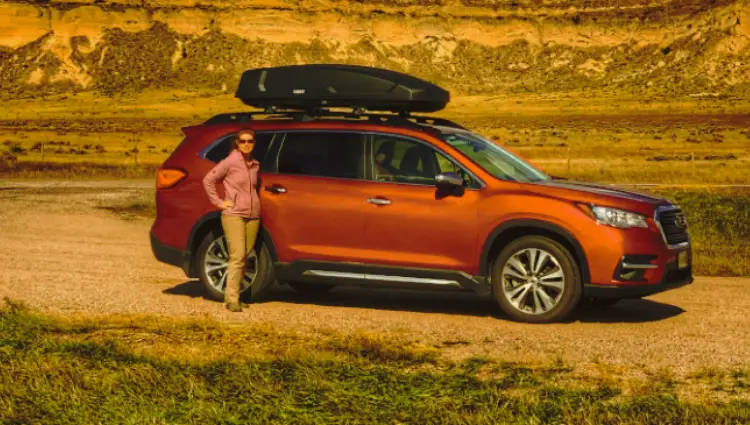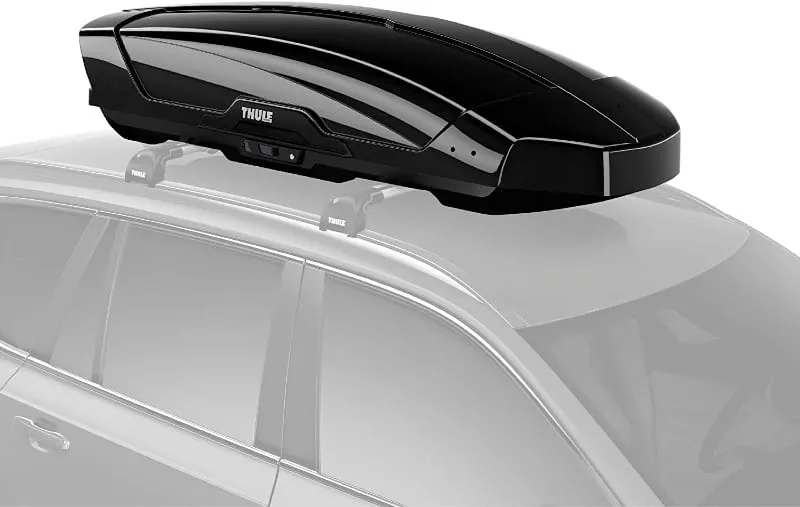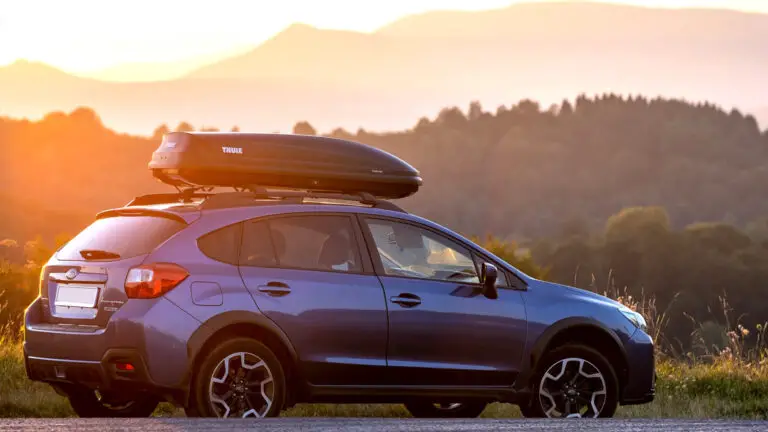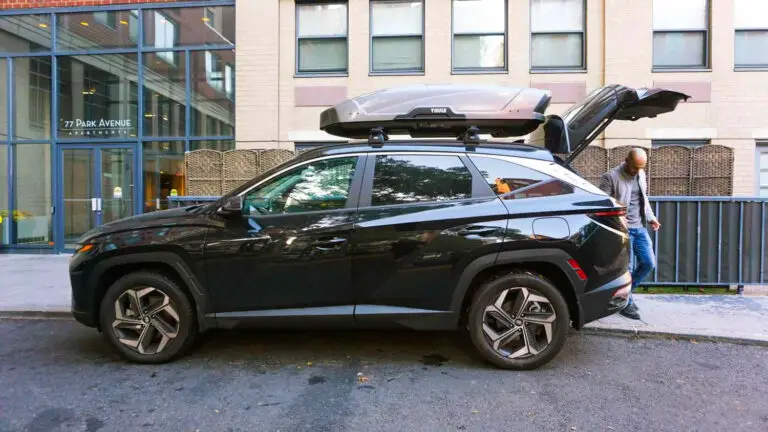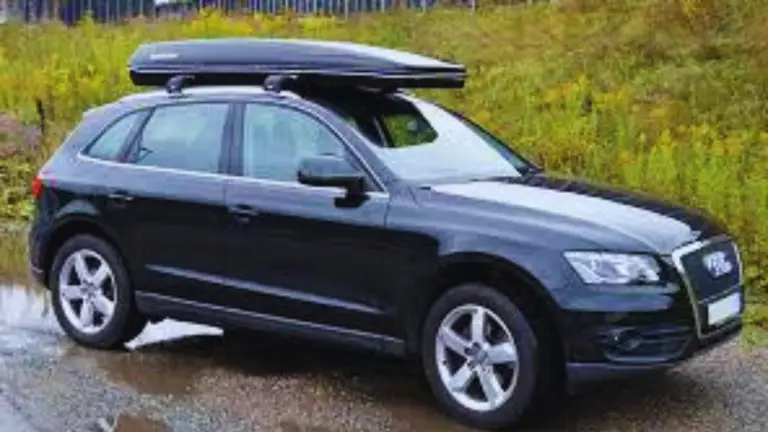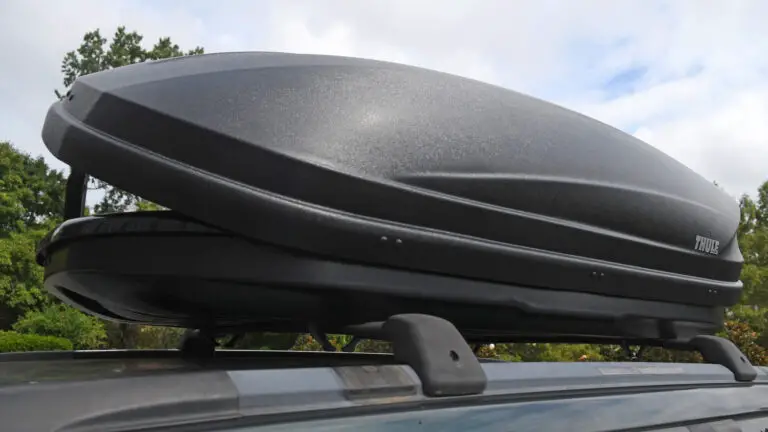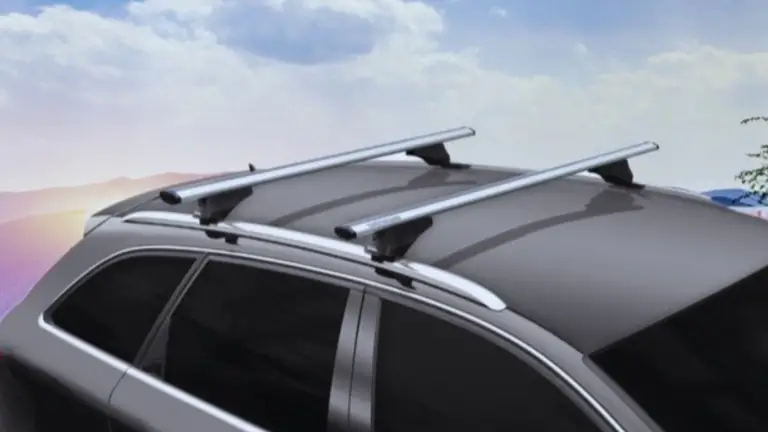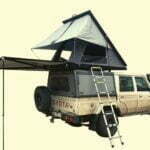Looking for a new roof box? Look no further, because we’ve got you covered! Unveiling the differences: Thule Force vs. Motion cargo boxes. Discover which Thule model suits your storage needs best for hassle-free travels.
Both have similar designs with unique features. We’ll also compare size variety, opening and closing mechanisms, storage capabilities, and design options. Whether you’re an avid skier or need extra storage, we’ll provide all the information you need to make an informed decision.
Let’s dive in and discover the differences between Thule Force and Motion!
Key Takeaways
- Thule Force and Motion have similar designs with a few differences in shape and dimensions.
- Both boxes come in various sizes, with Force having a Sport version and Motion having an Alpine version.
- The opening and closing mechanisms of the boxes differ, with Motion having a SlideLock system and Force having a lock knob.
- The gear storage capacity and volume are the same for both boxes, with no notable differences.
Box Shape and Dimensions
The box shape and dimensions of both the Thule Force and Motion are important factors to consider when choosing between the two models. The Motion has a slightly lower end and an angled back, providing better aerodynamics compared to the Force, which has a bumpier back end. The Motion’s angled back ensures that no air can get in between the base and lid, ensuring aerodynamic integrity.
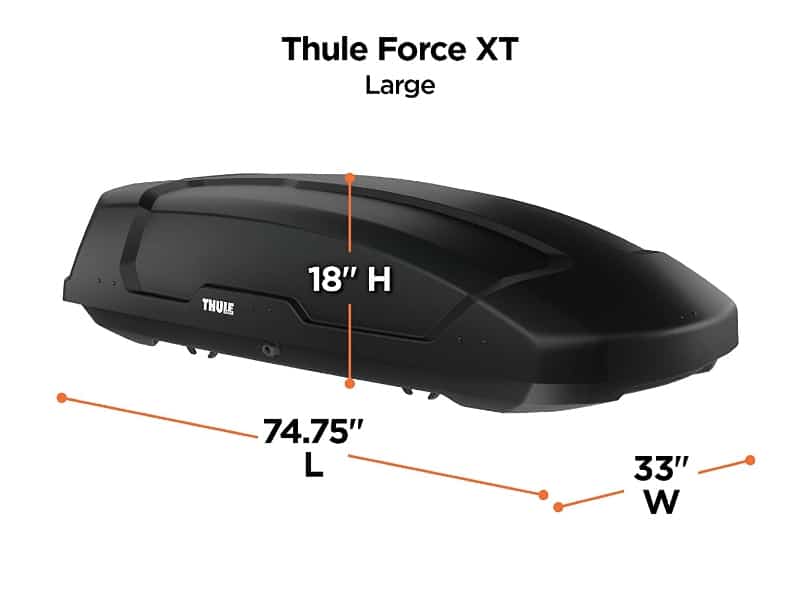
Both boxes have cutouts in the back for the car antenna. When it comes to load capacity, there are no notable differences between the two boxes. They both have the same gear capacity and volume, and the size of the box doesn’t affect the number of skis and snowboards it can store.
Ultimately, the choice between the two models comes down to personal preference in terms of design and color.
Size Variety
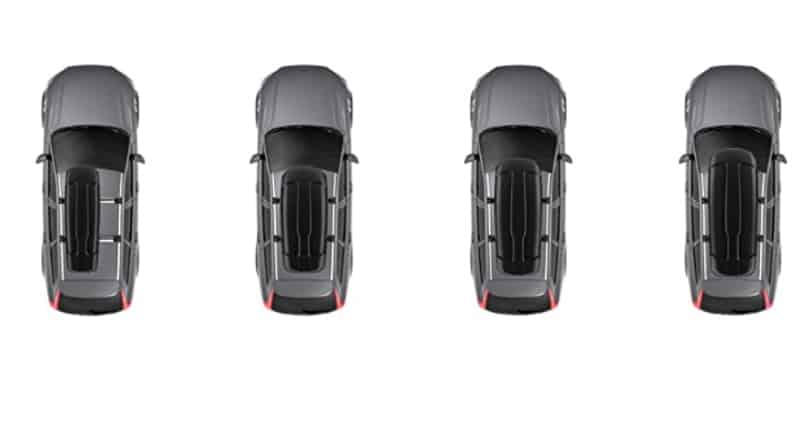
Both Force and Motion offer three staple sizes: L, XL, and XXL. However, there are some differences in terms of size variety between the two models.
The Thule Force also has a Sport version, which features a narrower high-profile design and a capacity of 11 cubic feet. On the other hand, the Thule Motion has an Alpine version specifically designed for carrying ski equipment. The Alpine version has a low-profile design and a larger capacity of 16 cubic feet.
When comparing the L and XL dimensions of the Force and Motion, they’re relatively similar in terms of gear capacity. Therefore, the choice between the two models ultimately comes down to factors such as price and color preference.
Box Opening and Closing
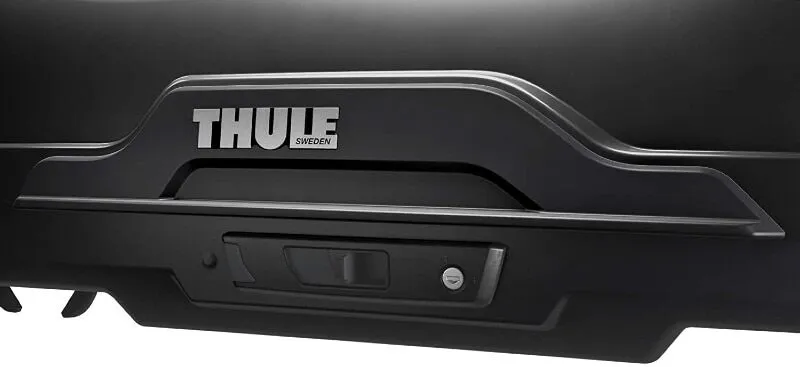
When comparing the Thule Force and Motion boxes, we found that they both have dual side openings but open in different ways. Here are the key differences between the two:
- Slide Lock vs Lock Knob: The Motion box features a SlideLock system with a key that automatically locks and unlocks the handle, while the Force box has a lock knob that you turn to unlock the box, with no handle.
- Audible Click and Visual Cues: The Motion box has an audible click and visual cues on the handle to indicate when the box is properly closed. This provides added assurance that your gear is secure.
- Safety Feature: Both boxes have a safety feature that prevents key removal until the box is closed and locked, ensuring that you don’t accidentally leave it unlocked.
- Ease of Use: The SlideLock system on the Motion box offers a more convenient and user-friendly experience, while the lock knob on the Force box may require a bit more effort to operate.
- Personal Preference: The choice between the two opening mechanisms ultimately comes down to personal preference and what you value most in terms of ease of use and security.
Gear Storage
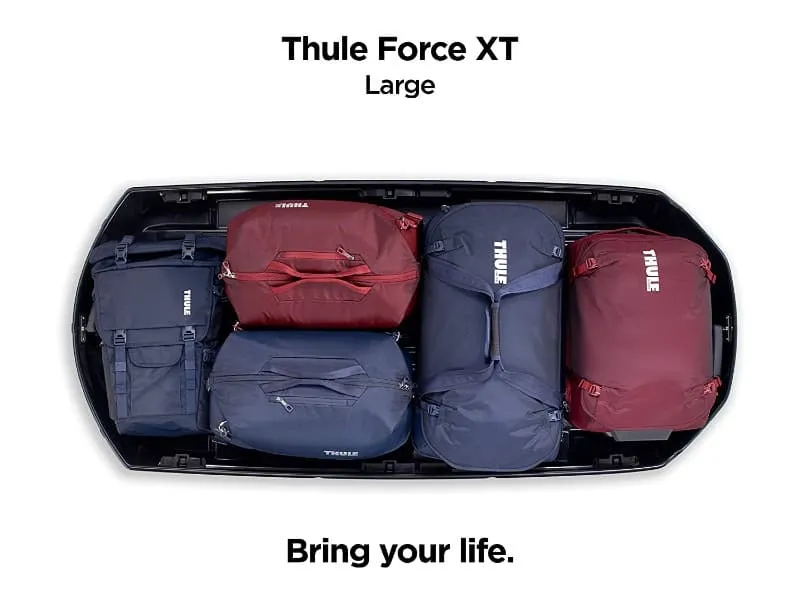
While comparing the Thule Force and Motion boxes, we noticed that there are no notable differences in load capacity and volume between the two. Both boxes have the same gear capacity, allowing you to store your belongings securely.
The interiors of both boxes are identical, featuring six metal tie-down points in the smallest boxes. Additionally, both boxes come with nylon straps to secure your gear to the metal bars, ensuring that everything stays in place during transport.
Whether you choose the Thule Force or Motion, you can trust that your gear will be well-secured and protected. So, when it comes to gear storage, both boxes offer the same level of reliability and convenience.
Design and Color
So, what sets the design and color of the Thule Force apart from the Thule Motion? Here are a few key differences to consider:
- Glossy vs Matte Finish: The Motion features a glossy finish, giving it a sleek and upscale look. On the other hand, the Force has a matte black finish, which gives it a more understated and rugged appearance.
- Personal Preference: The choice between the glossy finish of the Motion and the matte finish of the Force ultimately comes down to personal taste. Some people may prefer the high-end look of the glossy finish, while others may prefer the more subdued and durable look of the matte finish.
- Aerodynamic Integrity: The Motion’s design guarantees that no air can get in between the base and lid, ensuring maximum aerodynamic integrity. On the other hand, the Force is secure but doesn’t have the same level of aerodynamic integrity as the Motion.
Aerodynamics
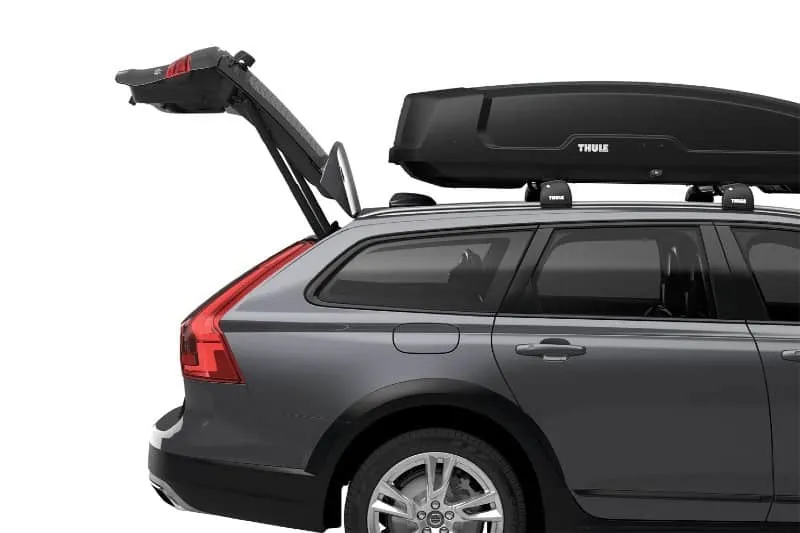
The Force offers secure storage, but the Motion provides superior aerodynamics. When it comes to wind resistance, the Motion has clear advantages over the Force. Its angled back and lower end design contribute to better aerodynamic performance, allowing for smoother airflow and less drag. This means that when driving at high speeds, the Motion will experience less resistance from the wind, resulting in improved fuel efficiency and a quieter ride. To illustrate the difference in aerodynamics between the two models, let’s take a look at the following table:
| Thule Box | Aerodynamic Advantages |
|---|---|
| Force | Secure storage |
| Motion | Superior aerodynamics, reduced wind resistance |
With its sleek and streamlined design, the Motion is the ideal choice for those who prioritize aerodynamic efficiency and want to minimize the impact of wind resistance while on the road.
Locking Mechanism
Our locking mechanism ensures the security of your belongings during travel. Here are some key features of the Thule Force and Motion locking mechanisms:
- SlideLock System: The Motion box features a SlideLock system with a key that automatically locks and unlocks the handle. This provides convenience and added security.
- Lock Knob: The Force box, on the other hand, has a lock knob that you turn to unlock the box. While it may not be as user-friendly as the SlideLock system, it still provides a secure locking mechanism.
- Safety Feature: Both boxes have a safety feature that prevents key removal until the box is closed and locked. This ensures that your belongings are safe and secure during transportation.
- Audible Click and Visual Cues: The Motion box has an audible click and visual cues on the handle to indicate when the box is properly closed. This gives you peace of mind knowing that your gear is securely stored.
- Security Pros and Cons: The SlideLock system of the Motion box offers convenience, but it may be more susceptible to tampering. On the other hand, the lock knob of the Force box provides a solid and reliable locking mechanism, but it may be less user-friendly. Ultimately, it comes down to personal preference and priorities when choosing between the two locking mechanisms.
Load Capacity
When comparing the Thule Force and Motion boxes, it’s important to consider the load capacity. Both boxes have the same gear tie-down points and offer ample space for your belongings.
The size of the box doesn’t affect the number of skis and snowboards it can store, but the length of skis that can be accommodated may vary based on the box size. Whether you choose the Force or Motion, you can expect to have enough room for all your gear.
The boxes provide secure storage and ensure that your items are tightly secured during transportation. So, whether you’re planning a ski trip or need extra space for your outdoor gear, both the Thule Force and Motion boxes offer excellent load capacity for your needs.
Price and Color Options
Thule Force
Motion
We have several price and color options available for both the Thule Force and Motion boxes.
When comparing the prices of the two boxes, it’s important to note that the Thule Force tends to be slightly more affordable compared to the Thule Motion. However, the price difference may vary depending on the size and version of the box.
As for color availability, the Thule Force is available in a stylish black AeroSkin design, giving it a sleek and modern look. On the other hand, the Thule Motion comes in two color options: grey and black, both with a glossy finish, adding a touch of sophistication.
Ultimately, the choice between the two boxes will depend on personal preference in terms of price and color.
Thule Force Vs. Motion: FAQs
Are the Thule Force and Motion Boxes Waterproof?
The Thule Force and Motion boxes have similar waterproofing capabilities. Both boxes are designed to be durable and low-maintenance, ensuring that your gear stays protected from water and other elements during your travels.
Can the Thule Boxes Be Installed on Any Type of Vehicle?
Yes, the Thule boxes can be installed on any type of vehicle. The installation process is straightforward and requires attaching the box to the roof rack using the provided hardware and following the instructions in the user manual.
Is There a Warranty Included With the Thule Force and Motion Boxes?
Yes, there is a warranty included with the Thule Force and Motion boxes. The warranty coverage ensures that any manufacturing defects or issues with the boxes will be addressed by Thule.
Are There Any Accessories Available for the Thule Boxes, Such as Cargo Nets or Dividers?
There are cargo net options and divider availability for Thule boxes. They provide additional organization and security for your gear. These accessories can be purchased separately to enhance your storage experience.
Can the Thule Boxes Be Easily Removed and Stored When Not in Use?
Yes, the Thule boxes can be easily removed and stored when not in use. They have a user-friendly design that allows for easy installation and removal, making storage a breeze.
Final Thoughts
In concluding thoughts, both the Thule Force and Motion roof boxes offer excellent options for those in need of additional storage space.
While the Force and Motion have similar designs, they have distinguishing features such as size variety, opening and closing mechanisms, and interior storage capabilities.
Whether you’re a skier or a road trip enthusiast, these roof boxes have you covered.
So don’t hesitate to choose the Thule box that best suits your needs and hit the road with style and convenience!
